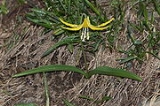
Erythronium grandiflorum
Encyclopedia
Erythronium grandiflorum is a species of flowering plant in the lily family
which is known by several common names, including yellow avalanche lily, glacier lily, and dogtooth fawn lily.
It is native to western North America from California
to Alberta
to New Mexico
. It can be found in subalpine
mountain meadows, slopes, and clearings.
The plant grows from a deep bulb
which is 3 to 5 centimeters wide. Its two green leaves are wavy-edged and up to 20 centimeters long. The stalk may reach 30 centimeters tall and bears one to three showy flowers. Each flower has bright lemon yellow tepals, white stamen
s with large white to yellow to red anthers, and a white style
. The flower is pollinated by bumblebee
s and other bees. The bulb
s are an important and preferred food of the grizzly bear
. Mule deer
readily eat the foliage.
Liliaceae
The Liliaceae, or the lily family, is a family of monocotyledons in the order Liliales. Plants in this family have linear leaves, mostly with parallel veins but with several having net venation , and flower arranged in threes. Several have bulbs, while others have rhizomes...
which is known by several common names, including yellow avalanche lily, glacier lily, and dogtooth fawn lily.
It is native to western North America from California
California
California is a state located on the West Coast of the United States. It is by far the most populous U.S. state, and the third-largest by land area...
to Alberta
Alberta
Alberta is a province of Canada. It had an estimated population of 3.7 million in 2010 making it the most populous of Canada's three prairie provinces...
to New Mexico
New Mexico
New Mexico is a state located in the southwest and western regions of the United States. New Mexico is also usually considered one of the Mountain States. With a population density of 16 per square mile, New Mexico is the sixth-most sparsely inhabited U.S...
. It can be found in subalpine
Subalpine
The subalpine zone is the biotic zone immediately below tree line around the world. Species that occur in this zone depend on the location of the zone on the Earth, for example, Snow Gum in Australia, or Subalpine Larch, Mountain Hemlock and Subalpine Fir in western North America.Trees in the...
mountain meadows, slopes, and clearings.
The plant grows from a deep bulb
Bulb
A bulb is a short stem with fleshy leaves or leaf bases. The leaves often function as food storage organs during dormancy.A bulb's leaf bases, known as scales, generally do not support leaves, but contain food reserves to enable the plant to survive adverse conditions. At the center of the bulb is...
which is 3 to 5 centimeters wide. Its two green leaves are wavy-edged and up to 20 centimeters long. The stalk may reach 30 centimeters tall and bears one to three showy flowers. Each flower has bright lemon yellow tepals, white stamen
Stamen
The stamen is the pollen producing reproductive organ of a flower...
s with large white to yellow to red anthers, and a white style
Gynoecium
Gynoecium is most commonly used as a collective term for all carpels in a flower. A carpel is the ovule and seed producing reproductive organ in flowering plants. Carpels are derived from ovule-bearing leaves which evolved to form a closed structure containing the ovules...
. The flower is pollinated by bumblebee
Bumblebee
A bumble bee is any member of the bee genus Bombus, in the family Apidae. There are over 250 known species, existing primarily in the Northern Hemisphere although they are common in New Zealand and in the Australian state of Tasmania.Bumble bees are social insects that are characterised by black...
s and other bees. The bulb
Bulb
A bulb is a short stem with fleshy leaves or leaf bases. The leaves often function as food storage organs during dormancy.A bulb's leaf bases, known as scales, generally do not support leaves, but contain food reserves to enable the plant to survive adverse conditions. At the center of the bulb is...
s are an important and preferred food of the grizzly bear
Grizzly Bear
The grizzly bear , also known as the silvertip bear, the grizzly, or the North American brown bear, is a subspecies of brown bear that generally lives in the uplands of western North America...
. Mule deer
Mule Deer
The mule deer is a deer indigenous to western North America. The Mule Deer gets its name from its large mule-like ears. There are believed to be several subspecies, including the black-tailed deer...
readily eat the foliage.

